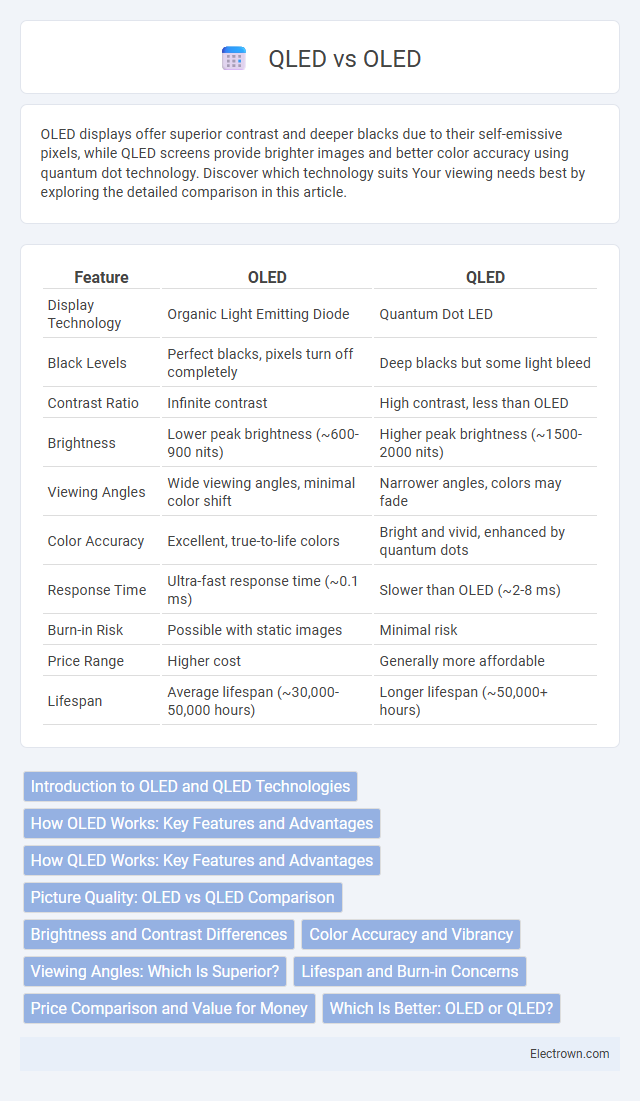OLED displays offer superior contrast and deeper blacks due to their self-emissive pixels, while QLED screens provide brighter images and better color accuracy using quantum dot technology. Discover which technology suits Your viewing needs best by exploring the detailed comparison in this article.
Table of Comparison
| Feature | OLED | QLED |
|---|---|---|
| Display Technology | Organic Light Emitting Diode | Quantum Dot LED |
| Black Levels | Perfect blacks, pixels turn off completely | Deep blacks but some light bleed |
| Contrast Ratio | Infinite contrast | High contrast, less than OLED |
| Brightness | Lower peak brightness (~600-900 nits) | Higher peak brightness (~1500-2000 nits) |
| Viewing Angles | Wide viewing angles, minimal color shift | Narrower angles, colors may fade |
| Color Accuracy | Excellent, true-to-life colors | Bright and vivid, enhanced by quantum dots |
| Response Time | Ultra-fast response time (~0.1 ms) | Slower than OLED (~2-8 ms) |
| Burn-in Risk | Possible with static images | Minimal risk |
| Price Range | Higher cost | Generally more affordable |
| Lifespan | Average lifespan (~30,000-50,000 hours) | Longer lifespan (~50,000+ hours) |
Introduction to OLED and QLED Technologies
OLED technology utilizes organic compounds that emit light when an electric current passes through, enabling individual pixel illumination and true black levels. QLED, or Quantum Dot LED, employs quantum dot semiconductor nanocrystals to enhance brightness and color accuracy in LCD backlit displays. Both technologies offer unique advantages in contrast, color precision, and energy efficiency tailored to different viewing preferences.
How OLED Works: Key Features and Advantages
OLED technology utilizes organic compounds that emit light when an electric current passes through, enabling each pixel to produce its own light independently. This results in superior contrast ratios, true blacks, and wider viewing angles compared to conventional display technologies. Key advantages include thinner panels, faster response times, and more energy-efficient operation, especially in darker scenes.
How QLED Works: Key Features and Advantages
QLED technology uses a quantum dot layer to enhance brightness and color accuracy by emitting precise wavelengths of light when illuminated by an LED backlight. Key features of QLED include higher peak brightness, superior color volume, and improved energy efficiency compared to traditional LED displays. These advantages result in vivid imagery and better performance in well-lit environments, making QLED TVs ideal for watching HDR content.
Picture Quality: OLED vs QLED Comparison
OLED displays deliver superior picture quality with perfect black levels and infinite contrast due to self-emissive pixels that turn off individually, enhancing overall image depth and color accuracy. QLED technology uses quantum dots to boost brightness and color volume, excelling in well-lit environments with vivid, vibrant images but may suffer from some light bleed affecting contrast. Your choice depends on preferences for deeper blacks and contrast (OLED) or higher brightness and vivid colors in bright rooms (QLED).
Brightness and Contrast Differences
OLED displays deliver perfect black levels and infinite contrast ratios by individually lighting each pixel, which enhances picture depth and detail, especially in dark scenes. QLED screens offer higher peak brightness using quantum dot technology, making them ideal for well-lit environments and HDR content. Your choice depends on whether you prioritize superior contrast for deeper blacks or intense brightness for vibrant visuals under bright lighting conditions.
Color Accuracy and Vibrancy
OLED displays offer superior color accuracy and vibrant colors due to their self-emissive pixels, which produce true blacks and a wider color gamut without backlight bleed. QLED technology enhances vibrancy through quantum dot filters, resulting in brighter images and more intense colors, especially in well-lit environments. Both technologies deliver impressive color performance, but OLED excels in deep blacks and precise color reproduction, while QLED stands out in brightness and vividness.
Viewing Angles: Which Is Superior?
OLED displays offer superior viewing angles compared to QLED screens, maintaining consistent color accuracy and contrast even when viewed from the side. QLED technology, while bright and vibrant, tends to suffer from color shifting and reduced contrast at wider angles due to its reliance on backlighting. Your choice for wide-angle viewing should favor OLED to enjoy a more uniform and immersive visual experience regardless of your seating position.
Lifespan and Burn-in Concerns
OLED displays offer superior contrast and color accuracy but have a lifespan typically around 30,000 to 50,000 hours before noticeable brightness degradation, with burn-in risks due to organic material aging. QLED screens, utilizing quantum dot technology with LED backlighting, boast longer lifespans exceeding 60,000 hours and are less susceptible to burn-in, making them more durable for static image display. Burn-in on OLEDs occurs when static images cause uneven pixel wear, whereas QLED technology's inorganic materials provide improved resistance to this issue.
Price Comparison and Value for Money
OLED displays typically command a higher price due to their superior contrast ratios and deeper blacks, making them ideal for cinematic experiences. QLED screens offer more affordable options with brighter panels and longer lifespan, providing excellent value for bright-room viewing. You can choose OLED for premium picture quality if budget allows, while QLED delivers solid performance at a lower cost, maximizing value for money.
Which Is Better: OLED or QLED?
OLED displays deliver superior contrast ratios and true blacks due to self-emissive pixels that individually turn off, enhancing image depth and color accuracy. QLED screens, powered by quantum dot technology, achieve higher brightness levels and better color volume, making them ideal for well-lit environments. Choosing between OLED and QLED depends on user preferences for picture quality, viewing conditions, and budget, with OLED excelling in dark-room performance and QLED offering brightness advantages.
OLED vs QLED Infographic

 electrown.com
electrown.com